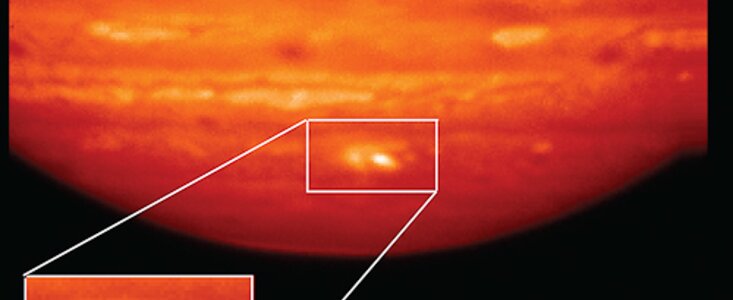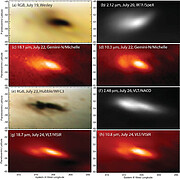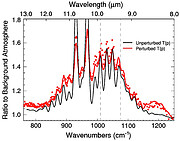2009 Collision with Jupiter - On the Rocks
January 26, 2011
26 Enero 2011
On July 19, 2009 Australian amateur astronomer Anthony Wesley spied a dark scar in the clouds of Jupiter. Wesley alerted professional astronomers and immediately both Gemini telescopes and other large telescopes around the world (and in space) trained their instruments on Jupiter’s new transient feature.
Now, after more than a year of studying the unique data a team led by Glenn Orton of NASA’s Jet Propulsion Laboratory and Leigh Fletcher of Oxford University have confirmed that this collision was not like at least one similar past event. The results, published in a recent issue of the journal Icarus (see citations at the end of this feature), indicate that the colliding body was rocky and not an icy comet like the last known collision with Jupiter, the comet Shoemaker-Levy 9 in 1994. These results confirm earlier indications from Hubble Space Telescope data that the collision involved a dense rocky object rather than an icy comet.
“Both the fact that the impact itself happened at all and the implication that it may well have been an asteroid rather than a comet shows us that the outer solar system is a complex, violent and dynamic place, and that many surprises may be out there waiting for us,” said Orton. “There is still a lot to sort out in the outer solar system.”
The Gemini data provided a critical mid-infrared window on the impact with a series of observations between July 22-24 using the imaging capabilities of MICHELLE on Gemini North (see Figures a & b) and spectroscopic measurements with T-ReCS on Gemini South (see geminiann11003c). The mid-infrared Gemini data indicated silica and silicates in the debris cloud left by the collision. The detection of silica in this mixture of Jovian atmospheric gases, processed bits from the impactor, and byproducts of high-energy chemical reactions is significant because abundant silica could only be produced in the impact itself, by a strong rocky body capable of penetrating very deeply into the Jovian atmosphere before exploding, but not by a much weaker comet nucleus. Assuming that the body had a rock-like density of around 2.5 grams per cubic centimeter (160 pounds per cubic foot), scientists calculated a likely diameter of 200 to 500 meters (700 to 1,600 feet). This is comparable to an object the mass of the Titanic.
The data from both Gemini telescopes as well as the NASA Infrared Telescope Facility (IRTF) and the European Southern Observatory’s Very Large Telescope (VLT) showed that the impact had warmed Jupiter's lower stratosphere by as much as 3 to 4 Kelvin about 42 kilometers above its cloud-tops. Although 3 to 4 Kelvin does not sound like a lot, it is a significant deposition of energy because it is spread over such an enormous area.
Plunging through Jupiter’s atmosphere, the object created a channel of super-heated atmospheric gases and debris. An explosion deep below the clouds – probably releasing at least around 200 trillion trillion ergs of energy, or more than 5 gigatons of TNT — then launched debris material back along the channel, above the cloud-tops, to splash back down into the atmosphere, creating the aerosol particulates and warm temperatures observed in the infrared. The blowback dredged up ammonia and other gases from a lower part of the atmosphere known as the troposphere into a higher part of the atmosphere known as the stratosphere.
"Comparisons between the 2009 images and the Shoemaker-Levy 9 results are beginning to show intriguing differences between the kinds of objects that hit Jupiter," Fletcher said. "The dark debris, the heated atmosphere and upwelling of ammonia were similar for this impact and Shoemaker-Levy, but the debris plume in this case didn’t reach such high altitudes, didn’t heat the high stratosphere, and contained signatures for hydrocarbons, silicates and silicas that weren’t seen before. The presence of hydrocarbons, and the absence of carbon monoxide, provide strong evidence for a water-depleted impactor in 2009."
Fletcher led the work [“The Aftermath of the July 2009 Impact on Jupiter: Ammonia, Temperatures and Particulates from Gemini Thermal Infrared Spectrospcopy,” Icarus, 211 (2011) 568-586] that finds three distinct aerosol features in the aftermath centered at 9.1, 10.0 and 18.5 microns specifically from the Gemini South T-ReCS data. These are consistent with particles of amorphous iron and magnesium-rich silicates and silicas entrained in the debris field.
Orton led the work [“The Atmospheric Influence, Size and Possible Asteroidal Nature of the July 2009 Jupiter Impactor,” Icarus, 221 (2011) 587-602] that presents both Gemini North and South mid-infrared data as well as that of the other telescopes (VLT and IRTF) to constrain the size of the colliding body and its rocky nature.
Gemini’s rapid response was possible due to the adaptability of queue-scheduled observations that allowed for non-time-critical events to be briefly delayed so that this event to be observed immediately as a director’s discretionary program.
Enlaces
- This summary is based on a web feature article by JPL, see here for the full JPL story and graphics.
- The Atmospheric Influence, Size and Possible Asteroidal Nature of the July 2009 Jupiter Impactor
- The Aftermath of the July 2009 Impact on Jupiter: Ammonia, Temperatures and Particulates from Gemini Thermal Infrared Spectrospcopy




